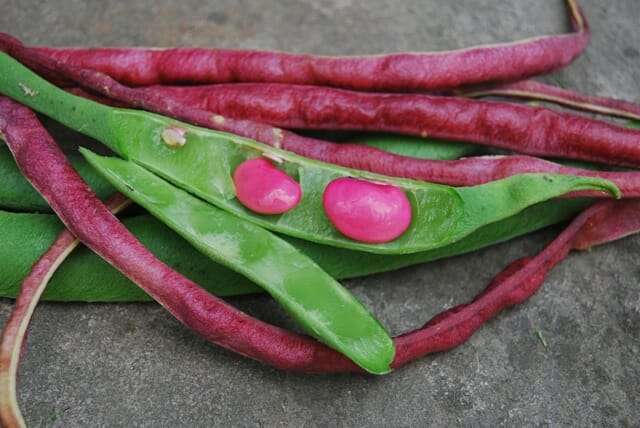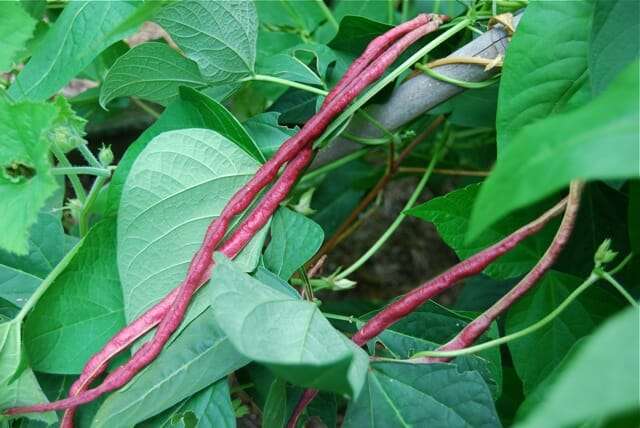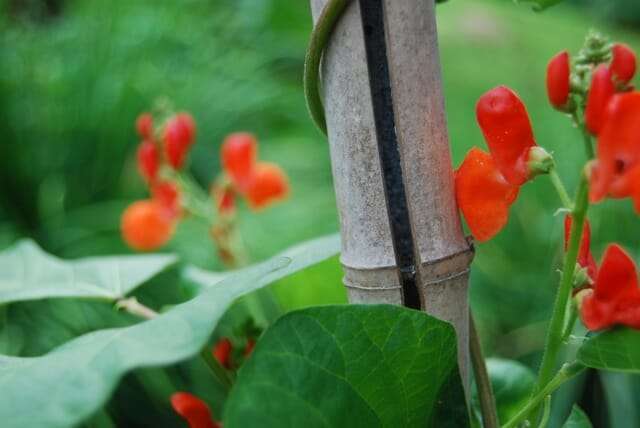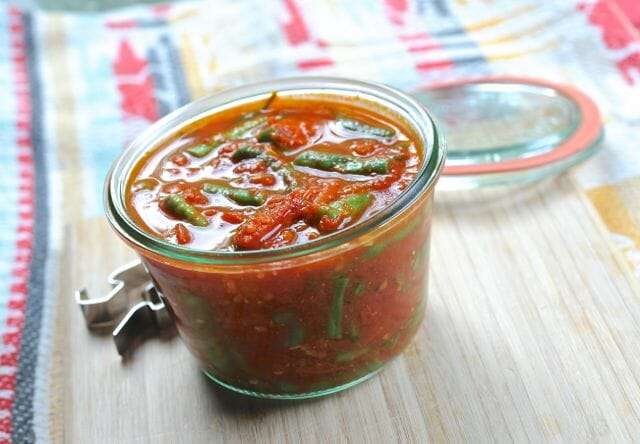favorite green beans, and a recipe for dilly beans

I want to introduce some oddball varieties I like to grow (like ‘Chinese Red Noodle’ and ‘Scarlet Runner,’ both shown above), and tell you what I’m planning to do with that Hefty-bagful of the more typical green bean types that I just harvested. (No, not 10 Pyrex baking dishes full of Grandma’s Green Bean Casserole with cream of mushroom soup, sour cream and butter-soaked Saltine crumbs and melted cheddar, though I am definitely tempted.)
Do you grow beans like ‘Royalty Purple Pod’ that are easy to spot on the vine when harvesting, but cook up green? Or slender filet beans, the haricot verts or filet beans of French cookery (and high priced in the grocery, if they’re even available)? Or yellow “wax” beans (pretty, but not my favorite for flavor, frankly)?
This year I’m growing one classic: ‘Blue Lake,’ the vintage-1960s bean of all those supermarket cans (the ones Grandma used in her casserole). I’ve found it prolific and tender, as the catalog promised, but nothing matches the tastiness of Italian-style flat-podded beans of the ‘Romano’ type. I love ‘Provider,’ too, and it really does provide picking after picking.



Lately I’ve read that we don’t really have the same kind of “deep freeze” that Grandma did, with all these frost-free modern freezers (read: warmer). They just don’t stay cold enough to do the trick, I fear, nor freeze things fast enough or consistently. Any other suggestions would be most welcome. Do you turn your freezer to the lowest (coldest) possible temperature when freezing fresh things, for instance, at least for awhile?
I’ll definitely use some of the harvest in a big batch or two of vegetable soup to freeze, and pickle the rest, as Dilly Beans (the recipe for which follows):
dilly beans recipe
(thanks to Rodale’s ‘Stocking Up’ food-preservation guide)
- 4 pounds green beans
- 8 dried 2-inch chili peppers
- 4 teaspoons mustard seed
- 4 teaspoons dill seed
- 8 gloves garlic
- 5 cups white vinegar
- 5 cups water
Prepare a brine of vinegar and water in a non-reactive pan (stainless or enamel, not aluminum), heating it to boiling.
While brine is heating, prep beans by cutting to lengths to fit in pint jars, cutting off any stem ends as well. Pack into hot, scalded jars. To each jar of beans add 1 pepper, 1⁄2 tsp. mustard seed, 1⁄2 tsp. dill seed, 1 clove garlic.
Pour boiling liquid into jars, leaving 1⁄4 inch of headroom only. Put on 2-part canning lids, then process in a boiling water bath for 5 minutes.





In the spirit of full disclosure, and this being bean day, I will admit that I just downed a giant saucepan full of penne with green beans, mingled with one of only three remaining freezer containers of ’07 red sauce. Good thing next week is our tomato event.
Oh, wow those scarlet runners are absolutely gorgeous! I’m going to have to plant those next year.
Thank you so much for the dilly bean recipe!!! I used to eat these all the time – I have a family farm and my aunts would make tons of dilly beans, but I’ve never made them myself – I think they will be my first canning project this year.
Welcome, Oakley Rhodes. The runner beans turn an amazing marbled purple/wine and black color when they are fully mature and dry, another of the many miracles in their life cycle. Enjoy them, and the dillies.
Greetings,
Just yesterday afternoon I went out and picked another huge amount of beans from my soggy VT garden and wondered, looking around at my countertops full of fresh beans, what to do? I ended up making a quick easy coconut fish stew that came out nicely, the only problem being that the purple beans turn green as they are prone to do and lose their fabulous color. Can be made without fish. Rich to be certain but somewhat healthy rich.
Saute an onion for awhile, throw in some carrots, open a can or two (depending on how many vegetables you have on hand) of coconut milk, add about a tablespoon of Thai red curry (less if you don’t love heat), bit of salt, and everything else your garden (or neighbor’s garden) has produced – broccoli, potatoes, dill, basil, &c. and as many beans as you have on the counter, and fish if you have some (I had some flounder and halibut in the freezer). Boil, then cover pot and cook on low heat for at least 15 minutes, (longer if potatoes are in the mix). Serve over rice. Tasty way to use many fresh vegetables & herbs that’s different from the salads or roasted vegetables that are usually on my own plate this time of year. Even better on dark stormy days with hail crashing down.
Thanks for all the great recipes,
philenor
Philenor – recipe sounds excellent- my English friends put their excess runner beans in a crock of salt to preserve them and they say they taste like fresh once they are retrieved and washed off- I have never had the nerve to try it- Has anyone else?
Welcome, Maggie (what some oldest friends still call me). Thank you for the recipe, and yes, there are so many great long beans to try, and as above Baker Creek has a lot of goodies on that score. Enjoy…and come back soon.
I love the unique varieties of plants you have. I have to grow those Chinese red noodles next year! I just finished harvesting and pulling out my bush beans. Here’s the one recipe I posted Green beans with mushrooms and thyme
Thanks for the welcome Margaret – I put up the link to my recipe on Deb’s blog. I am leaving you a link as well.
Some great recipes – I can’t wait to give them a try!
Welcome, Dlyn. I was so happy to have your participation, as your green bean and tomatoes recipe is just what I was talking about in my post, the Italian (and Greek) way to just have some yummy green beans. Thank you.
There is a version of Dlyn’s recipe that I have made that has more Southern than Italian or Greek origins. It’s great for using up those lunker beans- the ones that hid out in the vines until they got supersized. It’s pretty much the same stuff- cut up beans, onions, bacon, tomatoes, black pepper – put in a slow cooker for 10 hours or so. Pretty tasty.
@Nancy: Uh, “lunker beans”? Is that botanical Latin? I missed that part of class I think. :)
I think only my husband and banks call me Margaret at this point. I was a Margi as a kid. Thanks for the Baker Creek link. Someone else pointed me there earlier last week and I bought radish and kale seeds for the fall. They have a great selection.
OK, better late than never. Here’s my green bean post:
https://frugalupstate.blogspot.com/2008/08/green-beans-are-in.html
Thanks, Melanie. My friend Susan does the same thing…and even lets the Italian-style flat pods get extra-big for this purpose. So easy, so delicious.
I love to toss them in olive oil, some fresh herbs, salt and pepper…then grill them. YUM!
reminded me of my grandmas freezer she had in her basement that was nothing but frost and vegetable bags.
Welcome, Brandon. Your comment makes me smile, remembering the grandmas of so many friends who had those big old freezers in the basement full of goodness knows what. I don’t recall mine having one, but maybe…hmmmm…
Anyhow, do come see us again, and thanks for your visit.
Has no one mentioned green beans and potatoes? I make these with both fresh and frozen beans (although the only really good frozen ones are the tiny French beans they sell at Aldi.)
Steam both a good quantity of new potatoes (any potatoes will do, but new are best) skins on or off, your choice, and add to a cast iron skillet in which you have heated olive oil and a quantity of chopped garlic. Steam some beans, (small or large, but they should not be too old; Romano beans are good) and add to the skillet, toss and serve.
I sometimes skip the steaming, and make all from scratch in the skillet, but the texture is not the same.
Season with dill, rosemary, parsley thyme or what ever you have.
Margaret, I have had some success blanching green beans in boiling water for just 30 seconds, draining them and shocking them with an ice water bath before drying them, laying them out in a single layer on cake racks (for faster freezing and good air circulation), freezing them and then bagging them when frozen.
The beans still taste fresh and because they were just blanched before they were frozen, they can take a little more cooking without becoming overdone. They still aren’t as good as fresh, but they are far better than any frozen bean you can get at the store.
On another note, I cannot begin to tell you how helpful your blog has been. I am newly single and have taken over the care of a three acre garden at my country house most of which had been under the purview of my husband. I knew what to do with flowers and vegetables, but knew little about caring for trees, most shrubs, or the lawn. Thanks to you I am busy pruning wheelbarrows full of dead and deformed and branches, mowing up a storm and planning changes I want to make in the garden for next year. Thank you for helping me get my arms around a seemingly overwhelming challenge.
Welcome, Laura. The bean trick sounds so smart. The drying and freezing fast in single layers. Of course! Glad to help you tackle the wilderness with some horticultural occupational therapy. :) See you soon.
Really enjoy your site….
My frozen beans were always tough, but my close farmer friend told me to blanch for 2 mins only , then drain and immerse in ice cold water, I mean really ice cold, with ice cubes floating in the bowl to drop the temp as quickly as possible. Once icy cold, put on paper towels on cookie sheets then in the freezer, bag the next day. Since doing this we have enjoyed fresh tasting beans all winter long. Also, love to french cut the beans and saute in olive oil with onion and fresh garlic then add soy sauce. Ummm Ummm Good.
Welcome, Judy, and thanks for the tip — right in time. I just picked about 10 pounds of beans and was feeling panicky. :) Now I have the answer! See you soon.
Mmm, I love green beans with tomato sauce and ditalini! That was my favorite dish when I was little. We grow ‘parisiennes’, a French market variety. The only detractor is the aching back after hunching over the plants to search for their green pods. Maybe I’ll build one of those raised garden bed tables for them next year. Beans don’t have terribly large root masses, do they?
Growing these red noodle beans this year in Tulsa, OK. NOTE TO THOSE IN THE HEAT: these do JUST GREAT in the heat (114 degrees here a couple of weeks ago). Just picked another large handfull today, and a handful of these is a pot! I blanch them for 1-1/2 minutes, just long enough for them to begin to darken their bright red color (will turn purple, then green if cooked long enough).
Hi, Beverly. Good to know! I loved them and have to grow them again next year. Thanks for the reminder!